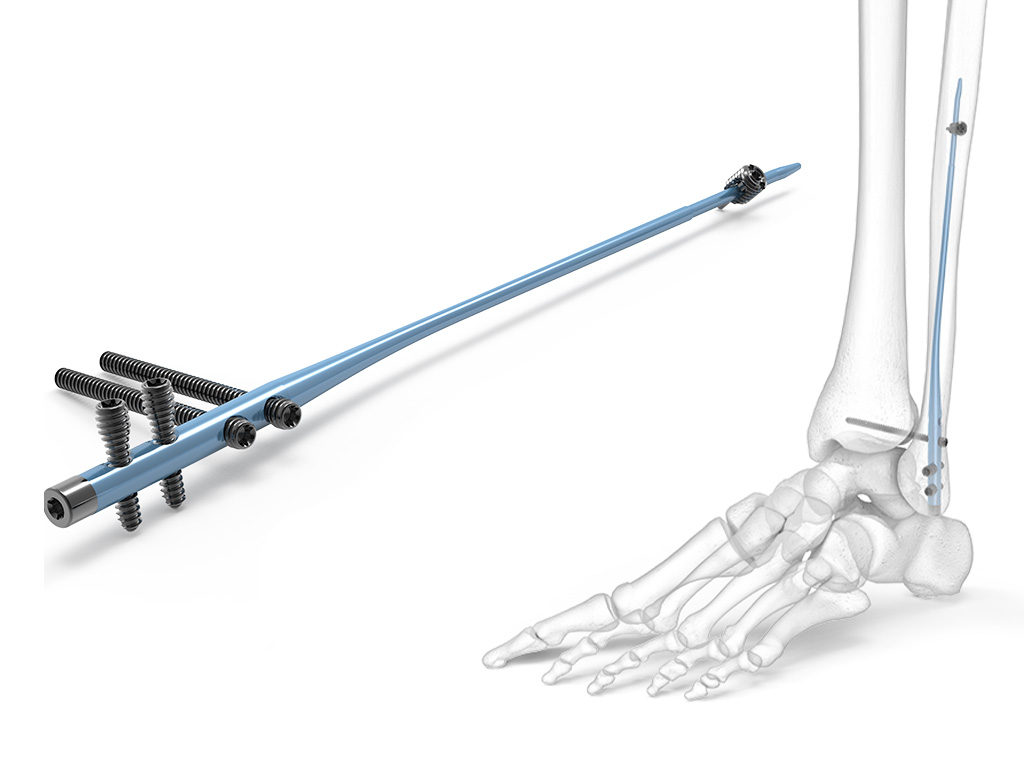
Fibula Nail 2 System
December 15, 2020
Designed in conjunction with Roy Sanders, MD, the Acumed Fibula Nail 2 includes three nail diameters and four length options, power reamers and carbon fiber radiolucent targeting guides to streamline the procedure, threaded holes within the nail, headless hexalobe screws to minimize soft-tissue irritation, and the option to lock the nail proximally, providing additional fixation within the canal. The Fibula Nail 2 must be used in conjunction with the Acumed Fibula and Forearm (FFN) Nail 2 Base Set, which contains universal instrumentation to implant the Fibula Nail 2, Ulna Nail 2, and screws.
Overview
Designed in conjunction with Roy Sanders, MD, the Acumed Fibula Nail 2 includes three nail diameters and four length options, power reamers and carbon fiber radiolucent targeting guides to streamline the procedure, threaded holes within the nail, headless hexalobe screws to minimize soft-tissue irritation, and the option to lock the nail proximally, providing additional fixation within the canal. The Fibula Nail 2 must be used in conjunction with the Acumed Fibula and Forearm (FFN) Nail 2 Base Set, which contains universal instrumentation to implant the Fibula Nail 2, Ulna Nail 2, and screws.
Indications for Use
The Acumed Fibula and Forearm Nail 2 System is intended for fixation of fractures and osteotomies of the fibula and ulna, including fractures where the medullary canal is narrow or flexibility of the implant is paramount.
Key Features
The intramedullary nailing technique has been shown to result in less damage to the soft tissues and vascular supply as well as lower refracture rates when compared to ORIF.1
- Minimally Invasive: The nail is inserted in the distal fibula through a minimal incision. Screws are inserted by making stab incisions to protect the soft tissue envelope and preserve vascularity of the periosteum.
- Rotation and Length Control: Tip-Loc technology provides the option to lock the nail proximally, providing additional fixation within the canal.
- Precontoured Design: The nail has a five degree bend intended to accommodate the shape of the canal of the fibula.
- Targeting Guide: The radiolucent carbon fiber targeting guide aids in the correct placement of A/P screw, L/M screw, and syndesmotic stabilization.
- Comprehensive Instrument Set: The Fibula and Forearm Nail 2 Base Set contains start-to-finish solutions for implanting and explanting the Fibula Nail 2 or Ulna Nail 2.
Comprehensive System
The Acumed Fibula Nail 2 is designed to address simple, transverse, and short oblique fractures as well as osteotomies of the fibula.
The Fibula Nail 2 includes:
- 12 nails offered in three diameters and four lengths including a small 2.6 mm diameter
- 5° bend in the nail designed to accommodate the shape of the intramedullary canal
- Power reamers and carbon fiber radiolucent targeting guides
- Threaded holes within the nail
- Two A/P and two L/M hole options
- L/M holes angled 8° superior to avoid the joint space and allow for syndesmotic reduction
- Headless hexalobe screws aim to minimize soft-tissue irritation
- Option to lock the nail proximally, providing additional fixation within the canal
The Fibula Nail 2 must be used in conjunction with the Acumed Fibula and Forearm Nail 2 Base Set, which contains universal instrumentation to implant the Fibula Nail 2, Ulna Nail 2 and screws.
Screws
3.5 mm Nonlocking Hexalobe (8-65 mm) and 3.5 mm Headless Hexalobe (12-65 mm) Screws are both included in the system. The 3.5 mm Headless Hexalobe screws lock into the threaded holes within the nail and are intended to create a low-profile construct to minimize soft -tissue irritation.
Optional Tip-Loc™ Bushing & Set Screw Kit
The Fibula Nail 2 offers the option to lock the nail proximally, providing additional fixation within the canal. The Tip-Loc Bushing and Tip-Loc Set Screw sit centrally within the last 1.5″ of the nail. These sterile packed implants are offered in 1 mm increments ranging from 6 mm through 16 mm in length.
Optional End Caps
End caps are offered in +0.4 mm, +5 mm, +10 mm, and +15 mm lengths and thread into the tail of the fibula nail. End caps assist in limiting ossification over the end of the nail, making the nail threads easier to engage if removal is desired. End caps also allow surgeons to create an intermediate nail length while adjusting for anatomic variances and screw trajectories.
Radiolucent Carbon Fiber Targeting Guides
Both the primary targeting guide, which aids in L/M screw placement, and secondary targeting guide, which aids in A/P screw placement, are radiolucent to allow for unimpeded viewing of the nail and screw positioning under fluoroscopy to ensure correct placement. The targeting guide components were designed to allow assembly only in one orientation in order to simplify the process for the scrub tech.
Drills
The FFN Near Cortex and Far Cortex drills offer a streamlined method of preparing the canal for the Tip-Loc bushing.
Citations
1. Lee YH, Lee SK, Chung MS, Baek GH, Gong HS, Kim KH. Interlocking contoured intramedullary nail fixation for selected diaphyseal fractures of the forearm in adults. J Bone Joint Surg Am. 2008;90:1891-1898.
